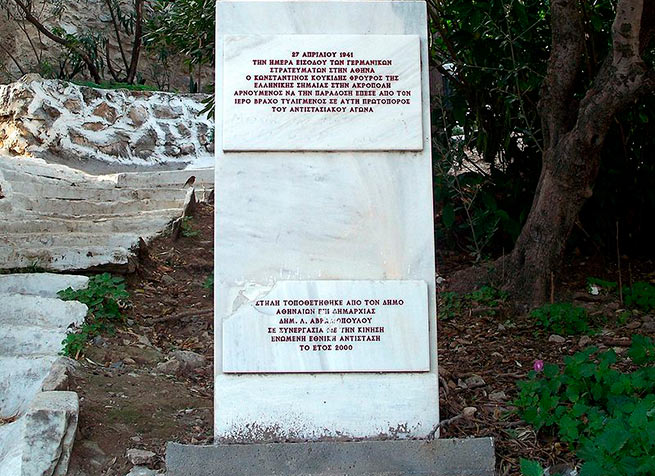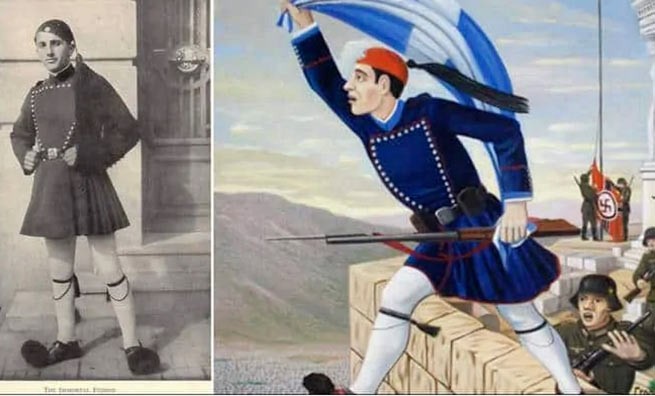On April 27, 1941, the day German troops entered Athens, guardian of the Greek flag on the Acropolis and resistance supporter Constantine Koukidis refused to surrender and jumped down from the shrine.
9 July 1941 British newspaper Daily Mail published an article “A Greek Carries his Flag To The Death” about an event in Athens that occurred during the entry of the Wehrmacht into the Greek capital. According to the article, on April 27, 1941, Evzone Guard soldier Konstantinos Koukidis guarded the flag that flew over the Acropolis of Athens.
After the Germans approached the Acropolis, a Wehrmacht officer demanded that Koukidis lay down his arms, lower the Greek flag and raise the flag of the Third Reich. Koukidis refused to comply with the German demands and instead, wrapped in a flag, jumped from the Acropolis and fell to his death..
According to legend, on Sunday, April 27, 1941, a military procession consisting of two motorcycles, a Kubelwagen all-terrain vehicle and a truck ascended from Thissio towards the Acropolis. High above him, on a pole, flies the Greek flag with a large white cross on a blue background. According to the terms of the armistice between Greece and Nazi Germany, the Greek army was disbanded. No one was supposed to guard the flag over the Acropolis. However, there was a guard there.
It was the first day that the young guy Konstantin Koukidis took up this post, and he was very proud. He is only 17 years old and is a member of the National Youth Organization. Just yesterday, the local Thissio youth committee decided that its young members would serve as flag guards until Germany decided, in cooperation with the occupying forces, what would happen next.
The young man believes that his responsibility is great, and he is obliged to protect the flag of his country. From the very early morning, he carefully put on the uniform of Evzone and went to the Acropolis, walked up to the flag and saluted. Then he took a few steps, right and left, to recognize the place, and then looked at it again and felt satisfied. From the walls of the Acropolis he saw German military vehicles moving slowly. He also heard the church bells that announced the Sunday liturgy. The guy was thinking about the Germans who entered Athens. He was worried about his brother, who had not yet returned from the front line. However, his heart was warmed by the waving flag, the eternal Acropolis and the sun of Attica…
At 8:45 a.m., a German detachment led by Captain Jakob and Lieutenant Elsnik reached the sacred rock of the Acropolis to raise the German flag. The officers ordered their soldiers to lower the Greek flag. However, the young Greek could not bear the humiliation of our national symbol. He took the flag, wrapped himself in it and threw himself from the top of the Acropolis. He died instantly. Koukidis's action made a great impression on the Germans and especially on their commander, who a little later reported this incident to the Higher Military Administration. Many say that Koukidis' sacrifice was the reason why the Greek flag was allowed to fly alongside the German flag, which is believed to have happened only in Greece and nowhere else in occupied Europe.
It is striking that, although in the early years there were oral and written testimonies about Koukidis' feat, for about 50 years this feat was forgotten or hushed up. The Germans went out of their way to hide this story to try to prevent an outbreak of patriotism among the Greeks under occupation. Later they preferred not to remember this story due to the fact that Kukidis was a member of National Youth Organization,under the prime minister Ioannis Metaxas.
However, eyewitnesses have given their own accounts of the story's authenticity, and Koukidis' sacrifice will not be forgotten. Kyriakov Giannakopoulos spoke about what happened:
“I was a child during the occupation and I remember well the stories of the residents of the Plaka area, which is located near the Acropolis, about the event. They lit candles at the icon in memory of the soldier who fell with the flag on the day the Germans arrived.”
Stathis Arvanitis, who was then a small child, recalls:
“I was seven years old then. We lived just below the Acropolis. April 27 was a sunny day with very clear skies. My father forbade me, my brother and mother to leave the house. I was on the terrace and playing with my car. Suddenly I see a body falling, it fell from the Acropolis and hit the rocks,” he said.

At the site where the event took place, a memorial plaque was erected in 2000 with the following inscription:
On April 27, 1941, the day German troops entered Athens, guardian of the Greek flag on the Acropolis and resistance supporter Constantine Koukidis refused to surrender and jumped down from the shrine. The stone was erected by the Municipality of Athens under Mayor Dim. L. Avramopoulos together with the National Resistance Association in 2000.
However, the fact of the feat is disputed by many people. Since the facts of the existence of Kukidis and his accomplishment of the feat were not established. One of the rare sources of information was the Greek New Democracy party, which indicated that Koukidis really existed and was a member of National Youth Organization,under the prime minister Ioannis Metaxas.
On April 26, 2000, the mayor of Athens, Dimitris Avramopoulos, said in an interview with the Eleftherotype newspaper that there was no documentary evidence clearly confirming the existence of Koukidis and his accomplishment of the feat, and this legend was probably invented by the Greeks to raise morale. The director of the history department of the Greek Army, Lieutenant General Ioannis Kakoudakis, said that the existence of Koukidis could not be verified[3].
Today, soldiers continue to guard the flag over Athens. The flag is raised at 6:30 in the morning and lowered at sunset by regular military personnel, while the Evzones, in their traditional uniform, raise and lower the flag on Sundays. Moreover, the fact that the swastika flag was raised over the Acropolis is not disputed: on May 30, 1941, Manolis Glezos and Apostolos Santas tore it down and tore it into pieces.
The Athens News translated a program featuring Manolis Glezos and Apostolos Santas, filmed in the 80s, which highlights the details of this feat.







More Stories
57 years ago, a junta of black colonels came to power in Greece.
On April 10, 1821, the Turks hanged Patriarch Gregory V at the Phanar gates
How did married couples divorce in Ancient Greece? Difference with modern divorces